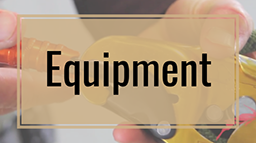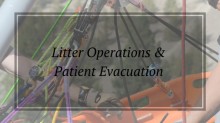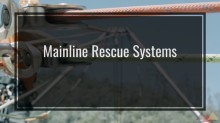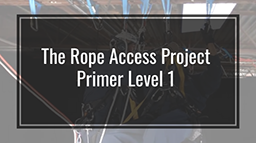About the Course
When it comes to equipping yourself for a rope rescue, you need the right equipment that is suited to your environment and situation. In this course, we will go over the different types of rope rescue equipment available to you and how to select the right gear for your needs. You’ll learn about the range of rope rescue equipment, and how to understand manufacturer’s specifications. We’ll cover topics such as what type of rope rescue equipment is available, how to choose the right gear for your situation, and how to safely use it in an emergency.
Rope rescue equipment is the most crucial component of the entire process. It ensures safety for technicians and can help facilitate a fast, effective rescue. When it comes to choosing and selecting the right rope rescue equipment, there are a few things to consider.
For starters, you’ll need to select harnesses, pulleys, ascenders, and rescue carabiners that are appropriate for the type of rope rescue you’ll be performing. It’s important to choose ones that are well-made, as they need to be able to bear the force of a rescue. You should also check for any certifications or standards that a product may have. Additionally, you should pay attention to the compatibility of the components you select – some rescue carabiners and ascenders are built for specific types of rope, so be sure your equipment works with the type of rope you’ll be using.
Once you’ve made your selection, it’s important to understand the proper application of each piece of rescue equipment. Different pieces are used for different purposes, so be sure to research and familiarize yourself with how each one is used. Learning how to use the right tools correctly is critical to a successful and safe rope rescue.
By taking the time to select and properly apply your rope rescue equipment, you can ensure that your rescue will go smoothly. With the right knowledge and gear, you can make sure that any rope rescue is carried out quickly, safely, and effectively.
What You’ll Learn
When it comes to rope rescue, the right equipment is essential. Choosing and selecting the appropriate gear for your rope rescue missions should be a top priority. The type of rope rescue equipment you need will depend on the situation and conditions, but here’s an overview of some common pieces of equipment used in rope rescue:
Ropes – These are one of the milestones of rope rescue. Nowadays, nylon and polyester ropes are proven to be the most reliable and practical. Different types of ropes have different combinations of core and sheath materials and technologies. Of course, they can be dynamic, low stretch or static; dynamic ropes stretch willingly to absorb the shock from falling, while low stretch and static ropes are more rigid and fit rescue operations well.
Pulleys – These devices serve to produce mechanical advantage and change the direction of the rope’s force. This useful machine works like a lever of different classes, thus giving you a mechanical advantage. If needed, you can build mechanical advantage systems using pulleys, ratchets, anchors, rope, and various connectors.
Harnesses – A harness is a link that connects a person to the safety, retrieval or rescue system. According to the NFPA, there are three categories of harnesses that contain different elements. All of them include, but are not limited to, straps, D-rings, or fastenings around the waist, thighs, and/or shoulders.
Helmets – A helmet is a critical piece of rescue gear. It shouldn’t be bulky or cause discomfort, plus it has to have excellent ventilation and full coverage protection to ensure ultimate safety of a rope rescue technician.
Ascenders – As the name suggests, we use these devices to ascend a fixed tope. This mechanical tool can also be used as a safety cam in a complex rescue system.
Connectors – Connectors are vital elements of any rope based system. They are used to connect different components, such as hurnesses or lanyards. Connectors are often used as anchor points and they usually work along the major axis. They can have screw or automatic locks, thus they should be chosen carefully depending on many factors. A Carabiner is a specific type of a connector that is a metal link used to join gear. Tri-links might be an alternative to carabiners, and are often chosen when there’s a need for three-way loading.
Litter (Rescue Basket) – This is a specific type of rescue stretcher used for carrying an injured person. In most cases, it can accommodate an adult and is used in spaces where there are obstacles to movement. A litter usually has straps that hold the person in the basket, thus making the evacuation process safer.
And So Much More!
Course Curriculum
Unit 1: Welcome
1.1 Welcome
1.2 Who Decides The Safety Equipment Testing Methods and Why? NFPA 2500 (1983)
1.3 Systematic Approach to Gear Selection, Care and Maintenance
1.4 Planning for Purchasing Equipment and or Gear Cache Revisions
Unit 2: Beginning the Process of Rope Rescue Program
2.1 Knowledge Is Really Not Left Behind
Unit 3: Equipment Selection
3.1 Let’s Get This Thing Started!
3.2 Creating Your Rope Rescue Equipment SOP
3.3 Your Gear Selection Considerations
3.4 Equipment Strength and Safety Factors
3.5 Load Ratios of Life Safety and Rescue Equipment
Unit 4: The Jigger System
4.1 The Jigger… What is it?
4.2 The AZTEK
4.3 Video Tutorial: A Visual Look at the AZTEK in Many Configurations
4.5 Petzl Jag System
4.6 SMC Advance HX Haul System
4.7 Harken Wingman
4.8 Harken Wingman – History and Collaboration
4.9 Harken Wingman – The Product
Unit 5: Rope, Webbing & Cord
5.1 Rope and Cord Overview
5.2 Rope Fibers
5.3 Rope Construction
5.4 Frequently Asked Questions Pertaining to Rope Construction
5.5 Rope Specifications
5.6 Webbing Overview
Unit 6: Harnesses
6.1 Harnesses
6.2 Belts
6.3 Sit Harnesses
6.4 Chest/Combo Harnesses
6.5 Full Body Harnesses
Unit 7: Carabiners
7.1 Carabiners Part 1
7.2 Carabiners Part 2
7.3 Carabiner Considerations
7.4 Carabiner Standards
7.5 Carabiner Use and Maintenance
7.6 Video Tutorial: Carabiner Overview
Unit 8: Pulleys
8.1 Pulleys Part 1 What Are They?
8.2 Pulleys Part 2 How They Work
8.3 Pulleys Part 3 Types General
8.4 Pulleys Part 4 Types Multi Purpose
Unit 9: Helmets
9.1 Helmets Overview
9.2 Rescue / Climbing Helmets
9.3 Industrial Safety Helmets
Unit 10: Rope Grabs and Ascenders
10.1 Grabs and Ascenders Overview
10.2 Fall Arrest
10.3 Rigging
10.4 Personal Handled Ascender
Unit 11: Braking Devices and Descenders
11.1 Braking Devices and Descenders Overview
11.2 Auto Locking and Manual Devices
11.3 More Considerations
11.4 Friction and Heat
11.5 Guideline for Selecting a Braking Device
11.6 Types of Braking Devices
11.7 Autolocking Braking Devices
11.8 Escape Devices
Unit 12: Anchor Hardware and Webbing
12.1 Anchors and Anchoring Introduction
12.2 Anchor Equipment Overview
12.3 Slings Straps and Lanyards
12.4 Plates
12.5 Swivels
Unit 13 Litters and Litter Rigging
13.1 Litter Types
13.2 Examples of Litters in Action… They are not created equal!
Unit 14: Wrap Up and FAQs
14.1 Wrap Up
14.3 Harnesses
14.3 Rope and Webbing
14.4 Rope Grabs
14.5 Carabiners and Connectors
14.6 Descenders
14.7 Ascenders
14.8 Pulleys
14.9 Helmets
14.10 Headlamps
Added Perks
Additional features Rigging Lab Academy Members are enjoying
Certificate of Completion
Download your personalized Certificate of Completion after completing the course.
100% Self-Paced
Go through the course material as fast or as slow as you’d like.
Private Discussion Board
Ask questions, meet other students, and even chat with the course instructor.





